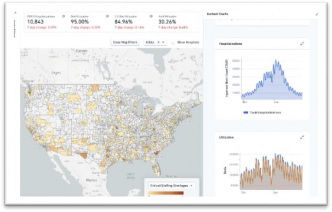HHS Protect – A common operating picture for COVID-19
Download PDF version [PDF – 2 pages]

Figure 1: HHS Protect Dashboard
HHS Protect is a secure decision-making and operations platform for the whole-of-government response to the COVID-19 pandemic. Since its launch in April 2020, HHS Protect, developed by the U.S. Department of Health and Human Services (HHS), has served as the common operating picture and central hub to collect, integrate, and share COVID-19 data in near-real time across federal agencies and with state, local, territorial, and tribal partners. HHS Protect streamlines and secures operations and brings together COVID-19 data for sharing among critical response partners. HHS Protect allows for key decision-making at every step of the COVID-19 pandemic response. On February 18, 2022, management and operational ownership of the HHS Protect system transitioned to the Centers for Disease Control and Prevention’s (CDC’s) National Center for Emerging and Zoonotic Infectious Diseases (NCEZID).
HHS Protect At a Glance
- Cases
- Testing
- Hospitalizations
- Mortality
- Mobility
- Schools
- Therapeutics
- Medical supply chains
- Demographics
- Local policy decisions
- Social determinants of health
- Healthcare system capacity
- Centers for Disease Control and Prevention (CDC)
- Centers for Medicare and Medicaid Services (CMS)
- HHS Administration for Strategic Preparedness & Response (ASPR)
- Federal Emergency Management
- Administration (FEMA)
- Department of Defense (DOD)
- National Institutes of Health (NIH)
- State, local, territorial, and tribal partners
- Providing pandemic-related data on U.S. government data-sharing portals such as CDC COVID-19 Data Tracker, healthdata.gov, and data.cdc.gov, as well as local and state public health websites.
HHS Protect Impact

- Provides a central source of data for the COVID-19 response and is used to inform operations and decision- making across the government.
- Provides speed and efficiency needed to translate public health data into actionable information.
- Creates interactive, geolocation-based
datavisualizations that integrate cases, deaths, testing, hospitalizations, and other metrics related to COVID-19. - Tracks COVID-19 trends from national to county levels; often used to inform key decisions, such as school closures.
- Compares vaccination status, case and death burden, requests for resources, medical personnel deployment, and other key data across regions.
- Uses shared hospitalization data to inform resource allocation and medical supply chain decisions.
- Leverages an interagency governance structure for resource and user management.
- Fosters data-driven discussions and collaboration between states and federal counterparts around topics that include hospital capacity, data quality issues and corrections, compliance issues, and general state needs.
- Documents all interactions within the platform, allowing follow-up and transparency of user access.
- Identifies data quality issues by using automated checks and alerts for incoming data, as well as supporting manual reviews and corrections.
- Secures data through detailed, government-defined access controls.